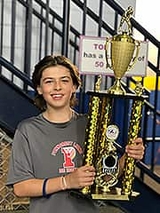Bronchus Tumor: Bennett’s Story
Bronchus Tumor: Bennett’s Story
Six years ago, Bennett had a collapsed lung because a rare, cancerous tumor blocked his airway. Today, Bennett, now 12, skates on three ice hockey teams and plays soccer, baseball and lacrosse.

His amazing recovery was due to the collaboration of several doctors at Children’s Hospital of Philadelphia who used state-of-the art skills and new therapies that allowed them to bypass the usual treatment: open chest surgery.
“The wonders of modern medicine, along with the great doctors Bennett had at CHOP, made all the difference,” his mother, Sara, says.
Asthma or pneumonia?
When Bennett first started having trouble breathing, he was diagnosed with asthma, but even using two types of inhalers, he wasn’t able to keep up with his classmates. “I kept thinking: What kind of asthma is this?” Sara recalls. Bennett remembers holding his arms above his head while playing hockey so he could breathe a little better.
When he developed a barking cough, doctors diagnosed him with pneumonia and treated him with antibiotics. When the cough returned, his parents took him to the doctor again. This time, Bennett had a chest X-ray. “His right lung looked like a spiderweb,” Sara says. “The doctor sent us straight to the ER.”
Doctors at a community hospital ER quickly determined he needed the advanced pulmonary care Children’s Hospital of Philadelphia could provide, and he was urgently transferred to CHOP.
Once in Philadelphia, he came under the care of pediatric pulmonologist Joseph Piccione, DO, MS, who initially thought the cough could be from a small object Bennett might have inhaled into the bronchus — where the windpipe (trachea) splits into two branches and flows into the lungs.
Flexible bronchoscopy to see blockage
In the operating room, Dr. Piccione performed a flexible bronchoscopy, where he put a tube with a camera and light attached down Bennett’s trachea and into the right bronchus so he could see what was causing the problem.
Dr. Piccione found a growth had completely blocked off Bennett’s right bronchus. Using flexible forceps in the working channel of the bronchoscope, he initially went to snip a sample of the tumor to send to the lab for analysis. But the tumor was soft, and most of it peeled away from the curve of the bronchus. Dr. Piccione, who leads CHOP’s Pulmonary Advanced Diagnostic Center, was able to remove about 95% of it right then. Once the tumor was no longer blocking the bronchus, the lung reinflated.
“Bennett felt better immediately,” Sara says. “He spent a couple of days in the ICU, and two days later he was discharged. He went from critical to stable to home in a few days. It was incredible.”
With the mass gone — and both lungs working — Bennett’s breathing returned to normal, but the remaining bit of the tumor needed to be dealt with. Treatment would be determined by the type of tumor. “It was a long two weeks waiting for the results of the tumor pathology,” Sara says.
Inflammatory myofibroblastic tumor
The lab report identified it as an inflammatory myofibroblastic tumor (IMT), a rare tumor found in only about 150 people each year. Add in that there are 20 U.S. children diagnosed with any type of airway tumor annually, and it’s clear Bennett’s case was an unusual one. Genetic testing showed Bennett had a cancerous IMT with an ALK gene mutation.
In partnership with Dr. Piccione and CHOP specialists from oncology and cardiothoracic surgery, the family decided to see if chemotherapy could kill off the remaining tumor so Bennett could be spared from having major surgery.
Drug trial at CHOP

In a happy coincidence, CHOP’s Cancer Center was in the midst of leading a trial of the oral chemotherapy drug crizotinib, a drug that had been shown to be effective in adults with ALK-mutated cancers, but which had not been used for children before and not for IMTs. Bennett began taking two doses a day.
It tasted horrible, so Sara would mask it with chocolate syrup. “That was the only part of this whole thing he struggled with,” she says.
To satisfy themselves that this was the right treatment protocol, Sara and Owen, Bennett’s father, sought a second opinion. The surgeon at the other hospital told them open surgery was needed to cut out the remaining part of the tumor. “We called Dr. Piccione and he said, ‘Don’t let them cut into the bronchus,’ so we went with his recommendation and told the other doctor no,” Sara says.
Freezing regrowth with cryotherapy
About 14 months after starting chemotherapy, Dr. Piccione saw a small regrowth of the tumor, but he still wanted to avoid surgery. Instead, Bennett’s treatment team decided to add cryotherapy while continuing crizotinib. Using a bronchoscope, he threaded a probe through the bronchoscope down Bennett’s trachea into the bronchus and used freezing gas to give the tumor “frostbite,” which killed it. While that treatment had been used in adults, cryotherapy had not been widely available for pediatric patients at the time. Bennett was one of the first children at CHOP to have the therapy. He had monthly cryotherapy sessions at CHOP for four months.
Overall, his treatment — individualized to his tumor, its location and type — lasted two years.
“It worked!” Sara says. “It’s been four years, and every bronchoscopy that Dr. Piccione has done have been clean. We’re so grateful.”
And the CHOP-driven drug trial of crizotinib led to U.S. Food and Drug Administration approval of the chemotherapy for adult and pediatric patients 1 year of age and older with inoperable, recurrent or refractory ALK-positive IMTs in June 2022.
‘Nice and funny’ staff, plus popsicles
At 12, Bennett is in every way a normal, healthy kid.
“I feel fine and don't have any breathing problems. My breathing has changed a lot — in a good way.”
From his many trips to CHOP for treatment and surveillance bronchoscopies, he remembers the nurses and doctors as being “really nice and sometimes funny,” and watching the new tower at Hospital at the University of Pennsylvania rise when he looked out his CHOP window. And something even better: “CHOP has amazing popsicles; I want them to tell me where they get them.”
Bennett is a four-sport athlete and an excellent student — especially in science and math. He spent two weeks at sleep away camp last summer. He’s a typical seventh grader who likes sleepovers and has a ton of friends.
His favorite sport? “Hockey because I have been playing it for a while and have gotten pretty good,” Bennett says. “It’s really fun skating around and meeting new people on my different teams.”
‘Like it never happened.’

Other than routine check-ups with Dr. Piccione, which keep getting spaced further apart every year, he doesn’t need to see other CHOP specialists.
“I had a really good experience at CHOP,” Bennett says. Thanks, Dr. P and all the nurses at CHOP who helped me get better!”
“It’s like it never happened — thank God and thank Dr. Piccione,” Sara says.